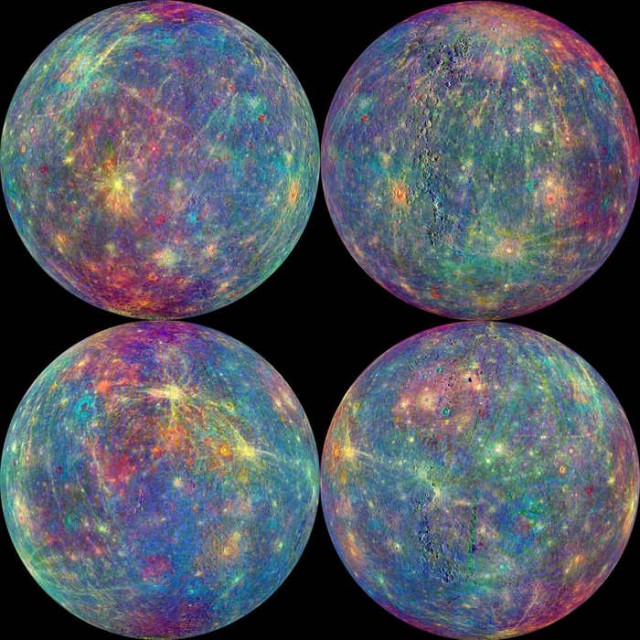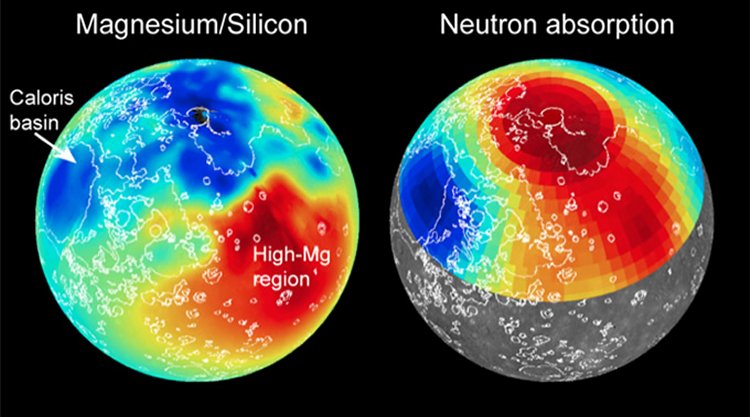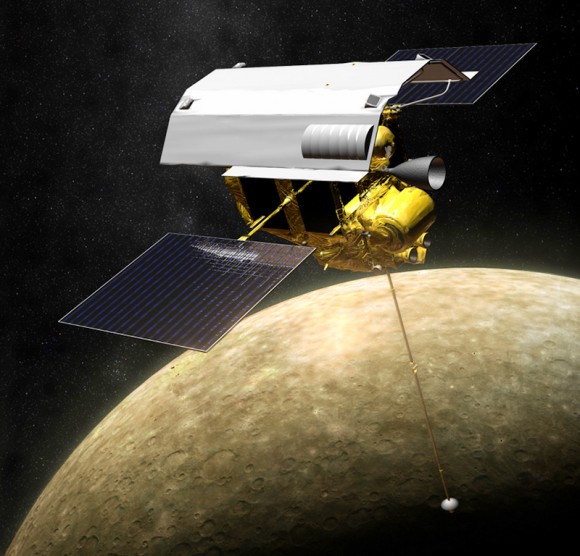
PAGE Table of Contents



Mercury These colorful composite new images of Mercury, provide colorful diversity of surface materials in never seen before detail. The Mercury Atmosphere and Surface Composition Spectrometer (MASCS) instrument aboard
NASAís MESSENGER spacecraft was designed to study both the exosphere and surface of the planet Mercury.

Maps of magnesium/silicon (left) and thermal neutron absorption (right) on Mercury's surface. Red represents high values and blue low ones.
Image credit: NASA/Johns Hopkins University Applied Physics Laboratory/Carnegie Institution of Washington -
See more at: http://sen.com/news/mercury-s-hidden-mantle-shows-up-in-new-maps#sthash.uTagBqP8.dpuf
This is the THe Messenger main website


MESSENGER launched from Cape Canaveral Air Force Station on August 3, 2004. It entered orbit around Mercury on March 18, 2011,
the first spacecraft ever to do so. Since then it has performed countless observations of our Solar Systemís innermost planet
and has successfully mapped 100% of its surface. Check out the infographic below showing some of the amazing numbers racked up by
MESSENGER since its launch ten years ago

A little over a week before NASAís MAVEN spacecraft fired its rockets to successfully enter orbit around Mars,
MESSENGER performed a little burn of its own Ė the second of four orbit correction maneuvers (OCMs) that will allow
it to remain in orbit around Mercury until next March. Although it is closing in on the end of its operational life
itís nice to know we still have a few more months of images and discoveries from MESSENGER to look forward to!
Delaying Death: Mercury Spacecraft Firing Engines To Stay Up Until 2015
Illustration of MESSENGER in orbit around Mercury (NASA/JPL/APL)
Donít take these spectacular Mercury images (below the jump) for granted.
Three weeks ago, NASAís orbiting Mercury spacecraft did an engine fire to boost its altitude above the hothouse planet.
Another one is scheduled for January.
Mercury MESSENGER Mission Concludes with a Smashing Finale!
by BOB KING on APRIL 30, 2015
Over and out! This is the final image acquired and transmitted back to Earth by MESSENGER this afternoon, April 30, 2015.
Weíre seeing a small area 0.6 miles (1 km) across on the floor of the 93-kilometer-diameter crater Jokai.
The spacecraft struck the planet just north of Shakespeare basin at the predicted time.
Credit: NASA/Johns Hopkins University Applied Physics Laboratory/Carnegie Institution of Washington
Mercury Spacecraft Moves To Testing Ahead Of 2016 Launch To Sunís Closest Planet
Artistís impression of the European Space Agencyís BepiColombo mission in operation around Mercury. Credit: Astrium
After facing down a couple of delays due to technical difficulties, Europeís and Japanís first Mercury orbiter is entering some
of the final stages ahead of its 2016 launch. Part of the BepiColombo orbiter moved into a European testing facility
this past week that will shake, bake and otherwise test the hardware to make sure itís ready for its extreme mission.
Name That Crater On Mercury! MESSENGER Team Opens Public Contest
by ELIZABETH HOWELL on DECEMBER 16, 2014t
The crater Scarlatti (at center) shines clearly in this image of Mercury taken by the MESSENGER spacecraft.
Credit: NASA/Johns Hopkins University Applied Physics Laboratory/Carnegie Institution of Washington
Hereís your rare chance to leave a lasting mark on a piece of the Solar System. The team behind the MESSENGER spacecraft ó
that machine orbiting Mercury since 2011 ó is asking the public to help them name craters on the planet, in an open contest.
Get a Change of View of Mercuryís North Pole
by JASON MAJOR on JANUARY 5, 2015
A forced perspective view of Prokofiev crater near Mercuryís north pole
Itís always good to get a little change of perspective, and with this image we achieve just that:
itís a view of Mercuryís north pole projected as it might be seen from above a slightly more southerly latitude.
Thanks to the MESSENGER spacecraft, with which this image was originally acquired, as well as the Arecibo Observatory here on Earth,
scientists now know that these polar craters contain large deposits of water ice Ė which may seem surprising on an airless
and searing-hot planet located so close to the Sun but not when you realize that the interiors of these craters never actually receive sunlight.
Click here to return to top of page